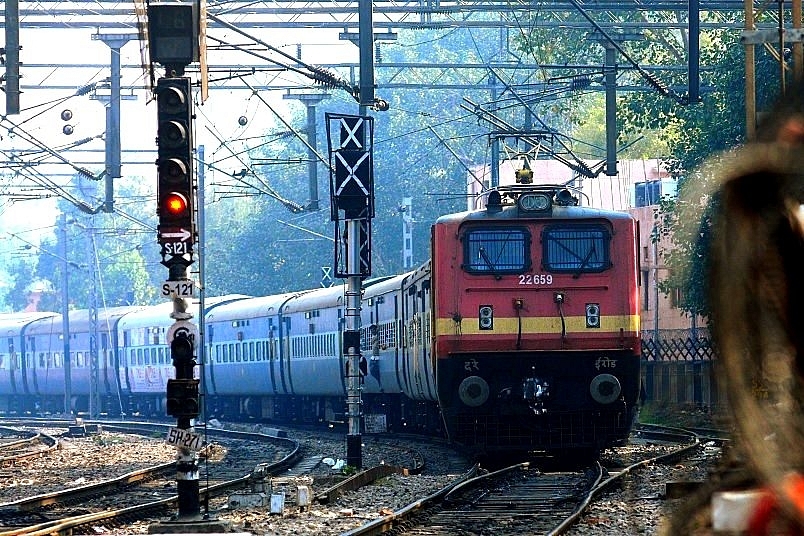News Brief
Train To Bangladesh: Defunct Haldibari-Chilahati Rail Link Opened After 55 Years
- This new rail link between India and Bangladesh will enhance rail network accessibility, support growth in regional trade and encourage economic and social development of the region.

An Indian Railways train. (representative image) (Ramesh Pathania/Mint via Getty Images)
In a major boost to economic activity and people-to-people contact in the region, another railway link between India and Bangladesh was opened on Thursday (17 December).
Defunct since the India-Pakistan war of 1965, the rail link between Haldibari in India and Chilahati in Bangladesh was inaugurated by Prime Minister Narendra Modi and his Bangladeshi counterpart Sheikh Hasina on Thursday, taking the number of operational rail links between the two countries to five.
With this new link coming into operation, tourists from Bangladesh will be able to visit places like Darjeeling, Sikkim, Dooars, apart from countries like Nepal and Bhutan, with ease.
Economic activities of these South Asian countries will also benefit from this new rail link, Indian Railways said. Modi and Hasina jointly inaugurated the railway link between Haldibari and Chilahati during a prime minister-level virtual bilateral summit.
Later, a goods train was flagged off by the Railway Minister of Bangladesh, Mohammad Nurul Islam Sujan, from the Chilahati station, which entered India passing through the international border, thus heralding a new era of friendship between the people living in both the countries.
The railway networks of India and Bangladesh are mostly inherited from the British-era Indian Railways. After the Partition in 1947, seven rail links became operational between India and the then East Pakistan (up to 1965). Currently, there are four operational rail links between India and Bangladesh.
They are Petrapole (India)-Benapole (Bangladesh), Gede (India)-Darshana (Bangladesh), Singhabad (India)-Rohanpur (Bangladesh), Radhikapur (India)-Birol (Bangladesh). The Haldibari-Chilahati rail link being made functional from 17 December is the fifth rail link between India and Bangladesh.
The Haldibari-Chilahati rail link was operational till 1965. This was part of the broad gauge main route from Kolkata to Siliguri during Partition. Trains travelling to Assam and north Bengal continued to travel through the then East Pakistan territory even after Partition.
For example, a train from Sealdah to Siliguri used to enter East Pakistan territory from Darshana and exit using the Haldibari-Chilahati link. However, the war of 1965 effectively cut off all the railway links between India and the then East Pakistan. So in the eastern sector of India, partition of the railways thus happened in 1965. So the importance of the reopening of this rail link can be well imagined, a statement from the railway ministry said.
In May 2015, in pursuance of the joint declaration at the Inter-Governmental Railway Meeting (IGRM) held in Delhi, the Railway Board sanctioned the construction of a broad gauge line of 3.5 km length from the Haldibari station to the Bangladesh border to connect with Chilahati in 2016-17 in order to reopen the erstwhile rail link.
While the Indian Railways has restored the tracks up to the international border from the Haldibari station at a cost of Rs 82.72 crore, the Bangladesh Railways has also undertaken upgrading and laying of missing tracks from the Chilahati station to the international border.
On the Bangladeshi side, the existing Chilahati-Parbatipur-Santahar-Darshana line is already in broad gauge. According to railways, the Haldibari-Chilahati route will be beneficial for transit into Bangladesh from Assam and West Bengal.
This newly-opened rail link will enhance rail network accessibility to the main ports, dry ports and land borders to support growth in regional trade and encourage economic and social development of the region.
Common people and businessmen of both the countries will be able to reap the benefits of both goods and passenger traffic once passenger trains are introduced on this route.
Support Swarajya's 50 Ground Reports Project & Sponsor A Story
Every general election Swarajya does a 50 ground reports project.
Aimed only at serious readers and those who appreciate the nuances of political undercurrents, the project provides a sense of India's electoral landscape. As you know, these reports are produced after considerable investment of travel, time and effort on the ground.
This time too we've kicked off the project in style and have covered over 30 constituencies already. If you're someone who appreciates such work and have enjoyed our coverage please consider sponsoring a ground report for just Rs 2999 to Rs 19,999 - it goes a long way in helping us produce more quality reportage.
You can also back this project by becoming a subscriber for as little as Rs 999 - so do click on this links and choose a plan that suits you and back us.
Click below to contribute.
Latest